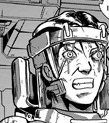- Lieutenant L. Z. Breanne(src)
- Sergeant Jon Littlefield(src)
- Breanne and Littlefield discussing neurally resocialized Marine Ardo Melnikov(src)
Neural resocialization is a process, devised by the Terran Confederacy, used to treat criminals suffering from mental disorders. The process usually involves sentencing the criminals into the military.[1] A number of mercenaries, such as Marcus Wright, have also undergone the experience as a result of having committed brutal crimes.[2]
Terrans sometimes refer to neural resocialization simply as "resoc"[2] or "brain panning"[3] (the latter term also refers to any form of insanity, brain damage, drug use or even simple stupidity).[4]
Neural resocialization bears many similarities to the technology used to control ghosts.[5]
Resocialized characters' minds are "fuzzy" when sensed by a telepath.[2]
History
Neural resocialization was commonly used as early as 2478[6] but was still considered new, "unproved" technology c. 2480.[5] The science has continuously advanced since then, having "new" forms by 2499.[3][7] Dominion scientist Dr. Burgess continues to advance the frontier of resocialization.[8]
During the tenure of the Terran Confederacy, most marines were resocialized, but near its end it claimed that only half of its marines were resocialized, "sometimes less".[3] The Confederacy took to kidnapping innocent civilians and converting them into marines during the war.[7] In the aftermath of the Brood War, the intake of resocialized marines has fallen slightly, but volunteers remain low, so the process has continued.[9]
Programming
- A "liberated" Marcus Wright(src)
There are multiple types of neural resocialization, but all share two things in common: they reshape the victim's memories (layering new memories over the old ones), and they enforce obedience (to different levels, depending on the type of resocialization). Neurally resocialized soldiers can shift loyalties if their commanders do so as well.[3][2]
The memory layering is "programmed"; the scientists "seek out" and "suppress" certain memories, such as emotionally charged violent criminal memories, covering them with "chocolate-coated" filler memories.[2]
Victims of some forms of resocialization are incapable of even pointing their weapon at another marine.[2][3]
Methods of Resocialization
By the beginning of the Great War, the Terran Confederacy had developed "non-invasive" forms of neural resocialization. Victims of the process had only a few physical outward marks (such as divots behind the ear). Their behavior was greatly modified; a resocialized individual was vulnerable to orders from even civilian personnel, and if given an order would follow it without thinking twice. While under the effects of stimulants, a resocialized marine would even shoot their own grandmother if given the order. They would not shoot possible "friendlies" without orders, however.[3]
A "milder" form of resocialization can be conducted in resocialization tanks. The victim is subjected to multiple sessions in the tanks, which program into them vital skills such as how to operate CMC armor. The recipient of the treatment is usually left disoriented for some time after the procedure. The victim of the procedure has few restrictions on behaviors, and is even capable of disobeying orders. The victim is free to attack other marines.[7] The technology continued to be used four years after the Brood War.[8]

Intense resocialization
More intensive forms of resocialization are considered to be extremely painful[2] and often involves brainwashing.[8]
Faults
- A "liberated" Marcus Wright(src)
Neural resocialization is not restricted to enlisted personnel; Lieutenant Emily Swallow of Alpha Squadron had undergone the process.[3] Notably, a number of obvious candidates have not undergone the process, such as Major Esmerelda Ndoci.[4]
Resocialized soldiers don't have initiative, tend to react poorly to changing battlefield conditions and tend to lack the depth of personality one might find in an ordinary human.[6]
Neural resocialization can "shatter" under stress. For instance, when the resocialized marine Lt. Emily Swallow faced stress when questioning a Sons of Korhal agitator, she had to use her StimPack to "relieve" the stress after the encounter. Later on, her previous criminal behavior came to the fore when she was attacked by zerg.[3] Trauma can also weaken the hold resocialization places on scrubbed memories.[6]
The Terran Dominion has discovered marine recruits who couldn't be tamed by resocialization as far back as 2500, and created the Reaper Corps from them. Reapers are chemically altered to make them even more aggressive, but are offered two year indentured terms (rather than a lifetime of resocialization). However, not a single reaper has survived six months within the Corps.[10]
A number of protoss have shown the ability to psionically reverse the process of resocialization.[2][8] Even terran psychics can undo the process to an extent (Atticus Carpenter being one of the more notable examples [11] ).[7]
References
|
